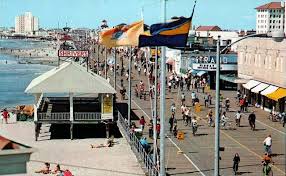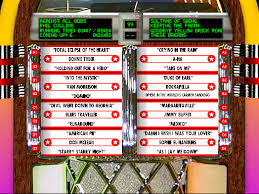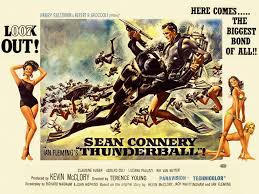Act II Episode 12 – #1 in ‘65
Number One in ’65


The Strand, Shriver's Candy, Shriver's Pavilion
The Strand, Shriver's Candy, Shriver's Pavilion
At any given point in time, at least in the ‘60s,
there was only one Number One. There was only one president of the United
States, one heavyweight champion of the world, one mob boss, and one hit song,
book and movie of the week, the last three based entirely on public taste and
sales figures.
LBJ was POTUS, the undisputed heavyweight champion of
the world Cassius Clay had yet to become Mohammed Ali, Angelo Bruno was the
boss of the Philadelphia and South Jersey Underworld while the hit song of the
week was heard on the radio, in juke boxes and played by every cover band on
the continent.
The Top 20 Songs of the Summer of '65 in the order they
appeared at #1 on the Pop Charts were:
Petula Clark - “Downtown”
Gary Lewis and the Playboys - “This Diamond Ring”
Righteous Brothers - “You've Lost that Lovin' Feeling”
The Temptations - “My Girl”
The Beatles - “Eight Days A Week”
Supremes - “Stop! In the Name of Love”
Freddie and the Dreamers - “I'm Telling You Now”
Wayne Fontaine and the Mindbenders – “Game of Love”
Herman's Hermits - “Mrs. Brown, You've Got a Lovely Daughter”
Beatles - “Ticket to Ride”
Beach Boys - “Help Me Rhonda”
Surpremes - “Back In My Arms Again”
Four Tops - “I Can't Help Myself”
Byrd's - “Mr. Tambourine Man”
Rolling Stones - “I Can't Get No (Satisfaction)”
Herman's Hermits - “Henry the VIII I Am”
Sonny & Cher - “I Got You Babe”
Beatles - “Help!”
Barry McGuire - “Eve of Destruction”
McCoys - “Hang on Snoopy”
I remember distinctly, over fifty years later, when I
first heard Gary Lewis and the Playboys’ “This Diamond Ring,” when it came on the juke box while I was eating a hot
dog and drinking a root beer with friends at the Chatterbox.
And it was totally appropriate, given the circumstances of that summer, for it to end with a song like Barry McGuire's "Eve of Destruction," because, as the summer drew to an end, there was the feeling that something imminently catastrophic was about to happen.
Not all of the songs deserve special mention, though
some, like the Byrd’s “Mr. Tambourine Man,” become entwined in the story of
what went down at the shore that summer. The Stones’ “Satisfaction (Can't Get No)” is one of the songs that
got them into the Steel Pier in Atlantic City, and the McCoys, riding “Hang on
Snoopy,” shared the bill with them and included hot guitarist Rick Derringer,
who would become one of the hot lead guitar gunslingers shooting for number
one.
Being Number One isn't everything - as with Hertz and Avis car rentals slogan, number two tries harder, and so it was with Dylan's greatest hit and masterpiece "Like A Rolling Stone" was the second most popular song of the summer of '65 - kept from making number one on the pop charts by the Beatles "Help!."
While national sales determine the hit song of the
week, and cover bands played all of the Top 20 hits, the local juke boxes
better exemplified the preferred musical tastes of the area, and the juke boxes
at the Chatterbox, Bob’s Grill, the College Grill, the Anchorage, Gregory’s, Point Diner and
other cafes and bars all reflect a different style – some hit songs of the past
years that remain popular at the Shore, such as Dion and the Belmont’s “Run
Around Sue,” “Pennies from Heaven,” “Bummin’ Around” and some of Johnny Caswell’s
songs that were put on the local juke boxes by special request.

The music was heard everywhere – on car radios, on transistor
radios on the beach, in the juke boxes and played by the hippies and folkies at
Shriver’s Pavilion and in the bars and nightclubs at the Point.
Books on the other hand, were pretty much a beach and
front porch thing in the summer time, and it was primarily little, handy
paperback books that you could fit in your back pocket and buy from racks at
the drugstore, retail shops and Monroe’s Book store on the boardwalk. There was
also a used book store just off the boardwalk on 11th street, one of
the last remnants of the old boardwalk.
For serious minds JFK was remembered by Arthur
Schlesinger in his “A Thousand Days” chronicle of his administration, and in
Theodore H. White’s distasteful “The Making of the President 1964.”
The new paperbacks ruled the beach however, and the
best sellers ran the gamut from Terry Southern's sexy "Candy," and Frank Herbert’s Sci Fi – “Dune,” Truman Capote’s
“In Cold Blood,” and Dr. Seuss’s “Fox in Socks,” to Beverly Cleary’s comic “The
Mouse and the Motorcycle.” There was Agatha Christie’s “At Bertram’s Hotel,” Noam
Chomsky’s linguistically unreadable “Aspects of the Theory of Syntax,” Robin
Moore’s “The Green Berets,” Arthur Hailey’s “Hotel.”

There was also some good spy fiction such as John le Carre’s “The Looking Glass War” and Ian Fleming’s “The Man with the Golden Gun,” though it would be Fleming's movie "Thunderball" tht would become part of the story as it played one of Mrs. Schilling’s boardwalk theaters that summer.
The Strand Theater before it was Multi-plexed by the Franks - the Neptune Curtain
Mrs. Helen Shriver Schilling owned all of the boardwalk theaters, the Strand at 9th Street being the biggest and most glorious, with its art deco ambiance, 2,000 seats, wrap around sound, huge screen and light blue silk curtain with the god Neptune rising from the sea that opened at the beginning of each screening.
Mrs. Helen Shriver Schilling owned all of the boardwalk theaters, the Strand at 9th Street being the biggest and most glorious, with its art deco ambiance, 2,000 seats, wrap around sound, huge screen and light blue silk curtain with the god Neptune rising from the sea that opened at the beginning of each screening.
Then there were the other theaters – the Village, just off the boardwalk at 7th Street and the Moorlyn, at Moorlyn Terrace across from the music pier, where the manager of all the theaters Mr. Oschlager had his office behind the big screen, and where at the front was an old unused vaudeville stage above the boardwalk stores where W.C. Fields and Sophie Tucker once performed.
The Village Theater
Then down at 12th street there was another big theater that had a stage, backstage, curtains, lights and all the works necessary to put on a Broadway play, as they used to do, but now was just used to screen movies.
The Strand got all of the big blockbusters – The Sound
of Music and Doctor Zhivago held sway there for most of the summer, along with “The
Greatest Story Ever Told,” with Max von Sydow as Jesus Christ, which gave Tido
Mambo’s Jesus routine a publicity boost, but the westerns, war movies, comedies
and spy flicks also packed the other theaters all summer long.
Among the westerns there was Clint Eastwood’s “For A
Few Dollars More,” “The Sons of Katie Elder,” with John Wayne and Dean Martin,
Jane Fonda and Lee Marvin in “Cat Ballou,” Jimmy Stewart’s “Shenandoah,” and
Sam Peckinpah’s “Major Dundee” with Charlton Heston.
The war movies included Frank Sinatra in “Von Ryan’s
Express,” “Battle of the Bulge,” with Henry Fonda and Robert Shaw, John Wayne “In
Harm’s Way,” “The Heroes of Telemark,” about Norwegian resistance fighters
during WW2, “Operation Crossbow,” and two military prison flicks “King Rat” and
“The Hill.”
The bizzare – “Faster, Pussycat! Kill! Kill!.” Peter
Sellers and Peter O’Toole in “What’s New Pussycat,” “Planet of the Vampires,” “Dr.
Who and the Daleks,”
The Sci-Fi “Alphaville,” was about “a U.S. secret
agent is sent to a distant space city of Alphaville where he must find a
missing person and free the city from its tyrannical ruler.”
Louis Malle’s “Viva Maria!,” about the daughter of an
Irish terrorist, Roman Polanski’s “Repulsion,” William Wyler’s “The Collector”
and Sir Laurence Olivier and Keir Dullea in Otto Preminger’s “Bunny Lake is
Missing,” round out the director’s cut.
Others that deserve mention include Elizabeth Taylor
and Richard Burton in “The Sandpiper” and Steve McQueen and Ann Margret in the
poker playing “Cincinnati Kid.”
Adventure movies included Peter O’Toole as “Lord Jim,”
“Ship of Fools,” and “The Naked Prey” safari as well as the “Flight of the
Phoenix,” which was taken from Shakespier’s “The Tempest,” where survivors of a
plane crash make a flyable plane from the wreckage, just as Captain Somers
inspired “The Tempest” when he sailed out of Bermuda with a boat built from his
ship wrecked in a storm.
The comedies included Hayley Mills and Dean Jones in “That
Darn Cat!,” “The Great Race,” with Tony Curtis, Natalie Wood and Jack Lemmon, and
“Those Magnificent Men in their Flying Machines or How I Flew from London to
Paris in 25 hours 11 minutes.”
Then there’s the Beatles “Help!” where “Ringo finds
himself the human sacrifice target of a cult and the band must try to protect
him from it,” and Richard Lester’s “The Knack and How to Get It,” about the
changing times with the rockers in mod London.

One of the more popular flicks of the summer was “Beach
Blanket Bing,” the fourth in the series of Frankie Avalon and Annette Funicello
beach party movies that include Harvey Lembeck as Eric Von Zipper, the leader
of a bumbling motorcycle gang who are like the Three Stooges as the Hells
Angels - “I come here to tell you dat dese beach bums is bums,” he says.
On a more somber note, and one that would bring the
Beach Blanket Bingo crowd to “On the Beach,” - “The War Game” set the mood of
doom as a “fictional, worst-case-scenario docudrama about nuclear war and its
aftermath in and around a typical English city.”
The spy flicks included Michael Caine in “The Ipcress
File” and “The Spy Who Came in From the Cold,” but Ian Fleming’s “Thunderball”
blew them all out of the water, so to speak.
The story of an international terrorist cartel known
as SPECTRE – Special Executive for Counter-intelligence, Terrorism and Revenge
hijacks two nuclear weapons from a bomber that ditched in the ocean to
blackmail the world, and a story that would become entwined with those enjoying
the Jersey Shore during that summer of 1965.



No comments:
Post a Comment